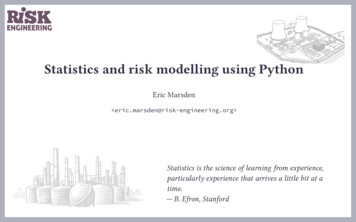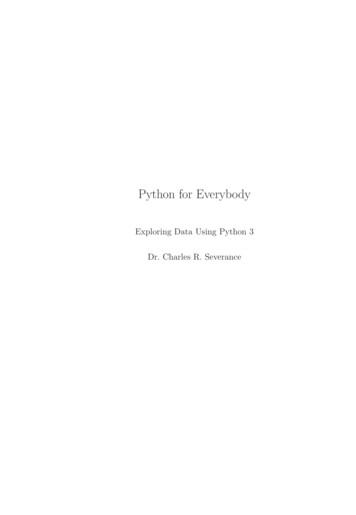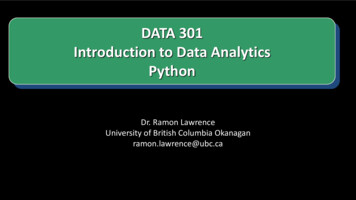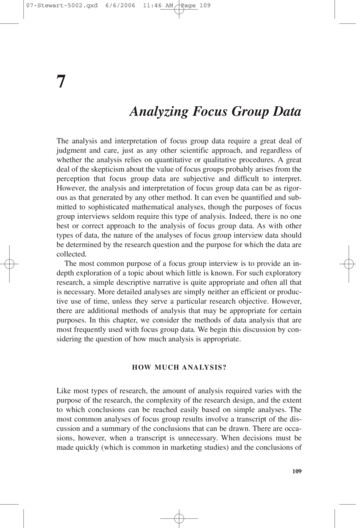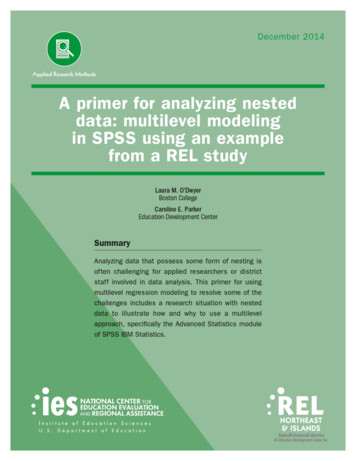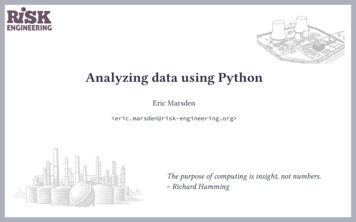
Transcription
Analyzing data using PythonEric Marsden eric.marsden@risk-engineering.org The purpose of computing is insight, not numbers.– Richard Hamming
Where does this fit into risk engineering?datacurvefittingprobabilistic modelconsequence modelevent probabilitiesevent consequencesrisks
Where does this fit into risk engineering?datacurvefittingprobabilistic modelconsequence modelevent probabilitiesevent consequencescostsriskscriteriadecision-making
Where does this fit into risk engineering?datacurvefittingprobabilistic modelconsequence modelevent probabilitiesevent consequencesThese slidescostsriskscriteriadecision-making
Descriptive statistics
Descriptive statistics Descriptive statistics allow you to summarize information aboutobservations organize and simplify data to help understand it Inferential statistics use observations (data from a sample) to makeinferences about the total population generalize from a sample to a population
Descriptive statisticsSource: dilbert.com
Measures of central tendency Central tendency (the “middle” of your data) is measured either by themedian or the mean The median is the point in the distribution where half the values arelower, and half higher it’s the 0.5 quantile The (arithmetic) mean (also called the average or the mathematicalexpectation) is the “center of mass” of the distribution𝑏 continuous case: 𝔼(𝑋) 𝑎 𝑥𝑓 (𝑥)𝑑𝑥 discrete case: 𝔼(𝑋) 𝑖 𝑥𝑖 𝑃(𝑥𝑖 ) The mode is the element that occurs most frequently in your data
Illustration: fatigue life of aluminium sheetingMeasurements of fatigue life(thousands of cycles until rupture) ofstrips of 6061-T6 aluminium sheeting,subjected to loads of 21 000 PSI.Data from Birnbaum and Saunders(1958). import numpy cycles numpy.array([370, 1016, 1235, [.] 1560, 1792]) cycles.mean()1400.9108910891089 numpy.mean(cycles)1400.9108910891089 numpy.median(cycles)1416.0Source: Birnbaum, Z. W. and Saunders, S. C. (1958), A statistical model for life-length of materials, Journal of the American StatisticalAssociation, 53(281)
Aside: sensitivity to outliersNote: the mean is quite sensitive to outliers, the median much less. the median is what’s called a robust measure of central tendency import numpy weights numpy.random.normal(80, 10, 1000) numpy.mean(weights)79.83294314806949 numpy.median(weights)79.69717178759265 numpy.percentile(weights, 50)79.69717178759265 # 50th percentile 0.5 quantile median weights numpy.append(weights, [10001, 101010])# outliers numpy.mean(weights)190.4630171138418# -- big change numpy.median(weights)79.70768232050916# -- almost unchanged
Measures of central tendencyIf the distribution of data is symmetrical, then the meanis equal to the median.If the distribution is asymmetric (skewed), the mean isgenerally closer to the skew than the median.Degree of asymmetry is measured by skewness (Python:scipy.stats.skew())Negative skewPositive skew
Measures of variability Variance measures the dispersion (spread) of observations around themean 𝑉 𝑎𝑟(𝑋) 𝔼 [(𝑋 𝔼[𝑋])2 ] continuous case: 𝜎2 (𝑥 𝜇)2 𝑓 (𝑥)𝑑𝑥 where 𝑓 (𝑥) is the probability densityfunction of 𝑋 discrete case: 𝜎2 1𝑛 1𝑛 𝑖 1 (𝑥𝑖 𝜇)2 note: if observations are in metres, variance is measured in 𝑚2 Python: array.var() or numpy.var(array) Standard deviation is the square root of the variance it has the same units as the mean Python: array.std() or numpy.std(array)
Exercise: Simple descriptive statisticsTask: Choose randomly 1000 integers from a uniform distributionbetween 100 and 200. Calculate the mean, min, max, variance andstandard deviation of this sample. import numpy obs numpy.random.randint(100, 201, 1000) obs.mean()149.49199999999999 obs.min()100 obs.max()200 obs.var()823.99793599999998 obs.std()28.705364237368595
Histograms: plots of variabilityHistograms are a sort of bar graph that showsthe distribution of data values. The vertical axisdisplays raw counts or proportions.To build a histogram:123Subdivide the observations into several equalclasses or intervals (called “bins”)import matplotlib.pyplot as plt# our Birnbaum and Sanders failure dataplt.hist(cycles)plt.xlabel("Cycles until failure")25Count the number of observations in eachinterval20Plot the number of observations in eachinterval10Note: the width of the bins is important to obtain a“reasonable” histogram, but is subjective.155050010001500Cycles until failure20002500
Quartiles A quartile is the value that marks one of the divisionsthat breaks a dataset into four equal parts The first quartile, at the 25th percentile, divides thefirst ¼ of cases from the latter ¾ The second quartile, the median, divides the dataset inhalf The third quartile, the 75th percentile, divides the first¾ of cases from the latter ¼25% ofobservations25% of observations25% of observations25% of observations The interquartile range (IQR) is the distance betweenthe first and third quartiles 25th percentile and the 75th percentileinterquartile range
Box and whisker plot the median (horizontal line) lower and upper quartiles Q1 and Q3 (the box) upper whisker: last datum Q3 1.5 IQR the lower whisker: first datum Q1 - 1.5 IQR any data beyond the whiskers are typically calledoutliersimport matplotlib.pyplot as pltplt.boxplot(cycles)plt.xlabel("Cycles until failure")2500Cycles until failureA “box and whisker” plot or boxplot shows the spread ofthe data200015001000500plot whiskersNote that some peopleththe 5th and les for examples max valu1
Violin plotAdds a kernel density estimation to a boxplot250020001500import seaborn as sns1000sns.violinplot(cycles, orient "v")plt.xlabel("Cycles until failure")5000Cycles until failure
Bias and precisionPreciseImpreciseBiasedUnbiasedA good estimator should be unbiased, precise and consistent (converge as sample sizeincreases).
Estimating values In engineering, providing a point estimate is not enough: we also need toknow the associated uncertainty especially for risk engineering! One option is to report the standard error , where 𝜎̂ is the sample standard deviation (an estimator for the populationstandard deviation) and 𝑛 is the size of the sample𝜎̂ 𝑛 difficult to interpret without making assumptions about the distribution of theerror (often assumed to be normal) Alternatively, we might report a confidence interval
Confidence intervals A two-sided confidence interval is an interval [𝐿, 𝑈] such that C% of thetime, the parameter of interest will be included in that interval most commonly, 95% confidence intervals are used Confidence intervals are used to describe the uncertainty in a pointestimate a wider confidence interval means greater uncertainty
Interpreting confidence intervalspopulationmeanmmmmmmmmmmA 90% confidence interval means that 10% ofthe time, the parameter of interest will not beincluded in that interval.Here, for a two-sided confidence interval.
Interpreting confidence intervalspopulationmeanmmmA 90% confidence interval means that 10% ofthe time, the parameter of interest will not beincluded in that interval.mmmmHere, for a one-sided confidence interval.mmm
Illustration: fatigue life of aluminium sheetingConfidence intervals can be displayedgraphically on a barplot, as “error lines”.import seaborn as snssns.barplot(cycles, ci 95, capsize 0.1)plt.xlabel("Cycles until failure (95% CI)")Note however that this graphical presentationis ambiguous, because some authors representthe standard deviation on error bars. Thecaption should always state what the error barsrepresent.020040060080010001200Cycles until failure, with 95% confidence intervalData from Birnbaum and Saunders (1958)1400
Statistical inferencepopulationsampleStatistical inference means deducinginformation about a population byexamining only a subset of thepopulation (the sample).We use a sample statistic to estimatea population parameter.
How to determine the confidence interval? If you make assumptions about the distribution of your data (eg. “theobservations are normally distributed”), you can calculate the confidenceinterval for your estimation of the parameter of interest (eg. the mean)using analytical quantile measures If you don’t want to make too many assumptions, a technique called thebootstrap can help General idea: I want to determine how much uncertainty is generated by the fact that I onlyhave a limited sample of my full population If I had a “full” sample, I could extract a large number of limited samples andexamine the amount of variability in those samples (how much does myparameter of interest vary across these samples?) I only have a limited sample, but I can look at a large number of limitedsamples from my own limited sample, by sampling with replacement
Bootstrap methods “Bootstrapping” means resampling your data with replacement Instead of fitting your model to the original 𝑋 and 𝑦, you fit your model toresampled versions of 𝑋 and 𝑦 many times Provides 𝑛 slightly different models from which we create a confidenceinterval Hypothesis: observations are the result of a model plus noise
Bootstrapping confidence intervals in Python1Take a large number of samples of the same size as our original dataset, bysampling with replacement2For each sample, calculate the parameter of interest (eg. the mean)3Calculate the relevant percentile from the distribution of the parameter of interestdef bootstrap confidence intervals(data, estimator, percentiles, runs 1000):replicates numpy.empty(runs)for i in range(runs):replicates[i] estimator(numpy.random.choice(data, len(data), replace True))est numpy.mean(replicates)ci numpy.percentile(numpy.sort(replicates), percentiles)return (est, ci)
Illustration with ExcelImport your data into the firstrow of a spreadsheet (here wehave 10 observations).Calculate the sample mean (lastcolumn) using functionAVERAGE.
Illustration with ExcelThe first replicate, placed in therow under the sample, isobtained by resampling withreplacement from the originalsample.Each cell contains the formulaINDEX(A1:J1,RANDBETWEEN(1, 10)),meaning “choose a randomelement from the first row”.Calculate the mean of the firstreplicate (last column) usingfunction AVERAGE.
Illustration with ExcelGenerate a large number ofreplicates (here 18), in successiverows of the spreadsheet.The mean of all the replicatemeans (here in bold) is thebootstrapped mean. Otherestimations such as confidenceintervals can be obtained fromthe blue column of replicatemeans.
Illustration: bootstrapped mean of Birnbaum dataLet’s calculate the bootstrapped mean and associated 95% confidence interval forthe Birnbaum and Saunders (1958) fatigue data. import numpy cycles numpy.array([370, 1016, 1235, [.] 1560, 1792]) cycles.mean()1400.9108910891089 est, ci bootstrap confidence intervals(cycles, numpy.mean, [5, 95]) print("Bootstrapped mean and CI: {:.1f} [{:.1f}, {:.1f}]".format(est, ci[0], ci[1]))Bootstrapped mean and CI95: 1403.7 [1332.8, 1478.9]
Fitting models
Fitting a distribution to observations The probability distributions defined in scipy.stats have a fit()method to find the parameters that provide a “best” fit more precisely, the maximum likelihood of being the best fit For example scipy.stats.norm.fit(data) scipy.stats.lognorm.fit(data) scipy.stats.expon.fit(data) scipy.stats.pareto.fit(data) They return different parameters depending on the distribution, withsome common parameters loc for the mean scale for the standard deviation
Example: material strength dataLet us examine material strength data collected by the USNIST. We plot a histogram to examine the distribution ofthe observations.Vangel material data (n 100)0.050.04import pandasimport matplotlib.pyplot as pltdata pandas.read csv("VANGEL5.DAT", header None)vangel data[0]N len(vangel)plt.hist(vangel, density True, alpha 0.5)plt.title("Vangel material data (n {})".format(N))plt.xlabel("Specimen strength")Data source: VANGEL5.DAT from NIST dataplot datasets0.030.020.010.0010203040Specimen strength5060
Example: material strength dataThere are no obvious outliers in this dataset. The distribution isasymmetric (the right tail is longer than the left tail) and theliterature suggests that material strength data can often be wellmodeled using a Weibull distribution, so we fit a Weibulldistribution to the data, which we plot superimposed on thehistogram.The weibull min.fit() function returns the parametersfor a Weibull distribution that shows the best fit to thedistribution (using a technique called maximum likelihoodestimation that we will not describe here).Weibull fit on Vangel data0.050.040.030.020.01from scipy.stats import weibull minplt.hist(vangel, density True, alpha 0.5)shape, loc, scale weibull min.fit(vangel, floc 0)x numpy.linspace(vangel.min(), vangel.max(), 100)plt.plot(x, weibull min(shape, loc, scale).pdf(x))plt.title("Weibull fit on Vangel data")plt.xlabel("Specimen strength")Data source: VANGEL5.DAT from NIST dataplot datasets0.0010203040Specimen strength5060
Example: material strength dataIt may be more revealing to plot the cumulativefailure-intensity data, the CDF of the dataset. Wesuperimpose the empirical CDF generated directly fromthe observations, and the analytical CDF of the fittedWeibull distribution.Vangel cumulative failure data1.0Empirical CDFWeibull fit0.80.6import statsmodels.distributionsecdf statsmodels.distributions.ECDF(vangel)plt.plot(x, ecdf(x), label "Empirical CDF")plt.plot(x, weibull min(shape,loc,scale).cdf(x),\label "Weibull fit")plt.title("Vangel cumulative failure intensity")plt.xlabel("Specimen strength")plt.legend()0.40.20.010203040Specimen strength5060
Example: material strength dataTo assess whether the Weibull distribution is a good fitfor this dataset, we examine a probability plot of thequantiles of the empirical dataset against the quantiles ofthe Weibull distribution. If the data comes from a Weibulldistribution, the points will be close to a diagonal line.In this case, the fit with a Weibull distribution is good.from scipy.stats import probplot, weibull minprobplot(vangel, \dist weibull min(shape,loc,scale),\plot plt.figure().add subplot(111))plt.title("Weibull probability plot of Vangel data")Weibull probability plot of Vangel data50Ordered ValuesDistributions generally differ the most in the tails, so theposition of the points at the left and right extremes of theplot are the most important to examine.604030201010203040Theoretical quantiles50
Example: material strength dataWe can use the fitted distribution (the model for our observations)to estimate confidence intervals concerning the material strength.For example, what is the minimal strength of this material, with a99% confidence level? It’s the 0.01 quantile, or the first percentileof our distribution. scipy.stats.weibull min(shape, loc, scale).ppf(0.01)7.039123866878374
Source: xkcd.com/2048, CC BY-NC licence
Assessing goodness of fitThe Kolmogorov-Smirnov test provides a measure of goodness offit.It returns a distance 𝐷, the maximum distance between the CDFsof the two samples. The closer this number is to 0, the more likelyit is that the two samples were drawn from the same distribution.Python: scipy.stats.kstest(obs, distribution)(The K-S test also returns a p-value, which describes the statistical significance of the Dstatistic. However, the p-value is not valid when testing against a model that has beenfitted to the data, so we will ignore it here.)
ExerciseProblemWe have the following field data for time to failure of a pump (in hours): 35682599 3681 3100 2772 3272 3529 1770 2951 3024 3761 3671 2977 3110 2567 33412825 3921 2498 2447 3615 2601 2185 3324 2892 2942 3992 2924 3544 3359 27023658 3089 3272 2833 3090 1879 2151 2371 2936What is the probability that the pump will fail after it has worked for at least2000 hours? Provide a 95% confidence interval for your estimate.
ExerciseSolution (1/3)import scipy.statsimport matplotlib.pyplot as pltDistribution of failure times (hours)0.0008obs [3568, 2599, 3681, 3100, 2772, 3272, 3529, 1770, 2951, \3024, 3761, 3671, 2977, 3110, 2567, 3341, 2825, 3921, 2498, \2447, 3615, 2601, 2185, 3324, 2892, 2942, 3992, 2924, 3544, \3359, 2702, 3658, 3089, 3272, 2833, 3090, 1879, 2151, 2371, 2936]# start with some exploratory data analysis to look at the “shape”# of the dataplt.hist(obs, density True)plt.title("Distribution of failure times 00045005000
ExerciseSolution (2/3)Distribution of failure times bability Plot4000Ordered Values# From the histogram, a normal distribution looks like a# reasonable model. We fit a distribution and plot an# overlay of the fitted distribution on the histogram,# as well as a probability plot.mu, sigma scipy.stats.norm.fit(obs)fitted scipy.stats.norm(mu, sigma)plt.hist(obs, density True, alpha 0.5)support numpy.linspace(obs.min(), obs.max(), 100)plt.plot(support, fitted.pdf(support), lw 3)plt.title("Distribution of failure times (hours)")0.0006350030002500fig plt.figure().add subplot(111)scipy.stats.probplot(obs, dist fitted, plot fig)20002000250030003500Theoretical quantiles4000
ExerciseSolution (3/3)def failure prob(observations):mu, sigma scipy.stats.norm.fit(observations)return scipy.stats.norm(mu, sigma).cdf(2000)# Estimate confidence intervals using the bootstrap method. This is# estimating the amount of uncertainty in our estimated failure probability# that is caused by the limited number of observations.est, ci bootstrap confidence intervals(obs, failure prob, [2.5, 97.5])print("Estimate {:.5f}, CI95 [{:.5f}, {:.5f}]".format(est, ci[0], ci[1]))Results are something like 0.01075, 𝐶𝐼95 [0.00206, 0.02429].
Illustration: fitting a distribution to wind speed dataLet us examine a histogram of wind speed data from TLSairport, in 2013.TLS 2013 wind speed data0.070.060.05data pandas.read csv("TLS-weather-data.csv")wind data["Mean Wind SpeedKm/h"]plt.hist(wind, density True, alpha 0.5)plt.xlabel("Wind speed (km/h)")plt.title("TLS 2013 wind speed data")0.040.030.020.010.00102030Wind speed (km/h)4050
Illustration: fitting a distribution to wind speed dataNormal fit on TLS 2013 wind speed data0.07We can attempt to fit a normal distribution to the data, andexamine a probability plot. (Note that the data distributionlooks skewed and the normal distribution is symmetric, so it’snot really a very good choice).0.06K-S test: D 1.0, p 0.00.050.040.030.020.01scipy.stats.probplot(wind, dist fitted,plot plt.figure().add subplot(111))plt.title("Normal probability plot of wind speed")Indeed, the probability plot shows quite a poor fit for thenormal distribution, in particular in the tails of thedistributions.0.001020304050Wind speed (km/h)Normal probability plot of wind speed5040Ordered Valuesshape, loc scipy.stats.norm.fit(wind)fitted scipy.stats.norm(shape, loc)plt.hist(wind, density True, alpha 0.5)x numpy.linspace(wind.min(), wind.max(), 100)plt.plot(x, fitted.pdf(x))plt.title("Normal fit on TLS 2013 wind speed data")plt.xlabel("Wind speed (km/h)")302010001020Theoretical quantiles30
Illustration: fitting a distribution to wind speed dataLognormal fit on TLS 2013 wind speed data0.07K-S test: D 0.075, p 0.030.06shape, loc, scale scipy.stats.lognorm.fit(wind)fitted scipy.stats.lognorm(shape, loc, scale)plt.hist(wind, density True, alpha 0.5)x numpy.linspace(wind.min(), wind.max(), 100)plt.plot(x, fitted.pdf(x))plt.title("Lognormal fit on TLS 2013 wind speed data")plt.xlabel("Wind speed (km/h)")scipy.stats.probplot(wind, dist fitted,plot plt.figure().add subplot(111))plt.title("Lognormal probability plot of wind speed")The probability plot gives much better results here.0.050.040.030.020.010.001020304050Wind speed (km/h)Lognormal probability plot of wind speed5040Ordered ValuesWe can attempt to fit a lognormal distribution to the data,and examine a probability plot.30201000102030Theoretical quantiles40
Exercise Download heat flow meter data collected by B. Zarr (NIST, 1990) on4/eda4281.htm Plot a histogram for the data Generate a normal probability plot to check whether the measurementsfit a normal (Gaussian) distribution Fit a normal distribution to the data Calculate the sample mean and the estimated population mean using thebootstrap technique Calculate the standard deviation Estimate the 95% confidence interval for the population mean, using thebootstrap technique
Analyzingdata
TLS 2013 wind speed data0.07Analyzing data: wind speed0.060.050.040.030.020.010.00 1020304050Wind speed (km/h)Normal probability plot of wind speedImport wind speed data for Toulouse airport50Find the mean of the distribution Plot a histogram of the data Does the data seem to follow a normal distribution?Ordered Values40 30201000102030Theoretical quantiles use a probability plot to checkWeibull probability plot of wind speed50 Check whether a Weibull distribution fits betterPredict the highest wind speed expected in a 10-year intervalOrdered Values40 302010001020Theoretical quantilesData downloaded from wunderground.com/history/monthly/fr/blagnac/LFBO30
Analyze HadCRUT4 data on global temperature change HadCRUT4 is a gridded dataset of global historical surfacetemperature anomalies relative to a 1961-1990 reference period1.0Average anomaly0.5 Data available frommetoffice.gov.uk/hadobs/hadcrut4/Exercise: import and plot the northern hemisphere ensemblemedian time series data, including uncertainty intervals0.0 0.5 1.0184018601880190019201940Year1960198020002020
Image credits Microscope on slide 41 adapted from flic.kr/p/aeh1J5, CC BYlicenceFor more free content on risk engineering,visit risk-engineering.org
Feedback welcome!This presentation is distributed under the terms of theCreative Commons Attribution – Share Alike licence@LearnRiskEngfb.me/RiskEngineeringWas some of the content unclear? Which parts were most useful toyou? Your comments to feedback@risk-engineering.org(email) or @LearnRiskEng (Twitter) will help us to improve thesematerials. Thanks!For more free content on risk engineering,visit risk-engineering.org
# start with some exploratory data analysis to look at the “shape” # of the data plt.hist(obs, density True) plt.title("Distribution of failure times (hours)") 2000250030003500400045005000 0.0000 0.0002 0.0004


